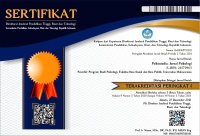Life Satisfaction of Emerging Adulthood in Indonesia: In the Shadow of Affluenza
Abstract
Life satisfaction is what every human being craves. Meanwhile, lifestyles and desires are increasingly dynamic and increasing day by day. In today's social environment, there is a phenomenon called affluenza, as a form of fulfilling a lifestyle during one's social environment. This study aims to introduce the phenomenon of affluenza in Indonesia, especially in its effect on life satisfaction itself. The research design was carried out quantitatively, by measuring variables using the affluenza scale which totaled 21 items and Cronbach's alpha of 0.840 as well as the life satisfaction scale with 5 items and Cronbach's alpha of 0.827. Respondents in this study were 110 people, who were taken using the snowball sampling technique. The presented data was processed using the linear regression test and r square, where the results of the data analysis showed P = 0.425 with an r square of 0.006. It can be interpreted that affluenza has no significant effect on life satisfaction and contributes 0.6%. So that it can be concluded that there is a need for further studies related to the affluenza phenomenon in Indonesia and exploration with other variables, considering that this research one of the first study to examine the affluenza phenomenon empirically in Indonesia.
Kepuasan hidup merupakan hal yang didambakan setiap manusia. Sementara itu, gaya hidup dan keinginan semakin dinamis dan meningkat kian harinya. Dalam lingkungan sosial saat ini, terdapat fenomena yang disebut affluenza, sebagai bentuk pemenuhan gaya hidup ditengah-tengah lingkungan sosial seseorang. Penelitian ini bertujuan guna mengenalkan fenomena affluenza di Indonesia, terkhusus dalam pengaruhnya terhadap kepuasan hidup itu sendiri. Desain penelitian dilakukan secara kuantitatif, dengan mengukur variabel menggunakan skala affluenza yang berjumlah 21 aitem dan alpha cronbach sebesar 0,840 Serta skala kepuasan hidup dengan aitem sebanyak 5 dan alpha cronbach sebesar 0,827. Responden dalam penelitian ini sebanyak 110 orang, yang diambil dengan menggunakan teknik snowball sampling. Data yang tersaji diolah menggunakan uji regresi linear dan r square, dimana hasil analisa data menunjukkan P = 0,425 dengan r square sebesar 0,006. Dapat diartikan bahwa affluenza tidak terlalu berpengaruh terhadap kepuasan hidup, dan memberikan kontribusi sebesar 0,6%. Sehingga dapat disimpulkan perlu adanya kajian lebih lanjut terkait fenomena affluenza di Indonesia serta eksplorasi dengan variabel-variabel lainnya, mengingat penelitian ini merupakan salah satu yang pertama dalam mengkaji fenomena affluenza secara empiris di Indonesia.
Keywords
Full Text:
FULL TEXTReferences
Ananta, A., & Suhadianto. (2022). Body Dissatisfaction Pada Wanita Masa Emerging Adulthood: Bagaimana Peranan Social Comparison dan Perfeksionisme. Psikostudia, 11(4), 532–541.
Argyle, M. (2001). The Psychology of Happiness (2nd ed.). Routledge.
Arnett, J. (2000). Emerging Adulthood: A theory of development from the late teens through the twenties. American Psychologist, 55(5), 469–480.
Astriewardhany, I., & Purnamasari, A. (2021). Dukungan sosial dan subjective well-being pada purnawirawan TNI. Empathy: Jurnal Fakultas Psikologi Ahmad Dahlan, 4(1), 30–44.
Borg, C., Hallberg, R., & Blomqvist. (2006). Life satisfaction among older people with reduced selfcare capacity: The relationship to social, health, and financial aspects. Journal of Clinical Nursing, 15, 607–618.
Boven, L., & Gilovich, T. (2003). To do or to have? That is the question. Journal of Personality and Social Psychology, 85(6), 1193–1202.
Carter, T., & Gilovich, T. (2010). The Relative relativity of material and experiental purchases. Journal Pers. Soc. Psychol, 98, 146–159.
Countney, E. (2019). Life satisfaction theory and 4 contributing factors. https://positivepsychology.com/lifesatisfaction/
Daniel, J. (2019). Gaya hidup konsumtif akibat majunya perekonomian Indonesia semakin menyisihkan orang miskin. https://doi.org/https://www.google.com/amp/s/theconversation.com/amp/gaya-hidup-konsumtif-akibat-majunya-perekonomian-indonesia-semakin-menyisihkan-orang-miskin-109334
DeGraaf, J., Wann, D., & Naylor, H. (2005). Affluenza: The All Consuming Epidemic. Berrett-Koehler Publishers.
Diener, E., & Diener, M. (2009). Cross-cultural correlates of life satisfaction and self-esteem in culture and well-being. Springer.
Dittmar, H., Bond, R., Hurst, M., & Kasser, T. (2014). The relationship between materialism and personal well-being: A meta analysis. Journal of Personality and Social Psychology, 107(5), 8799–8924.
Jatmika, D. (2017). Hubungan budaya individualis-kolektif dan motivasi berbelanja hedonik pada masyarakat kota Jakarta. Jurnal Psikologi Psibernetika, 10(1), 9–19.
Kahneman, D., & Deaton, A. (2010). High income improves evaluation of life but not emotional well being. Proceedings of the National Academy of Sciences, 107(38), 16489–16493.
Karni, A. (2018). Subjective well-being. Jurnal Syi’ar, 18, 84–102.
Kashdan, B., & Breen, E. (2007). Materialism and diminished well-being: experimental avoidance as a mediating mechanism. Journal of Social and Clinical Psychology, 26, 521–539.
KPPBC, T. E. (2015). Indonesia konsumtif, ayo berubah! https://bctemas.beacukai.go.id/indonesia-konsumtif-ayo-berubah/
Ku, L. (2015). Development of materialism in adolescence: The longitudinal role of life satisfaction among Chinese youths. Social Indicators Research, 124(1), 231–247.
Kuenzel, S., & Halliday, V. (2008). Investigating antecedents and consequences of brand identification. Journal of Product and Brand Management, 17(5), 293–304.
Mahmud, Z., & Amat, S. (2009). The relationship between assertiveness and satisfaction with life among students at a higher learning institution. Jurnal Pendidikan Malaysia, 34(2), 49–65.
Malik, M., Najam, A., Khalily, M., & Ansari, M. (2018). Relationship between affluenza, psychological wellbeing and life satisfaction among doctors and lawyers. Rawal Medical Journal, 43(3), 520–523.
Mamta, S., & Harjyot, K. (2018). Affluenza: A barrier to psychological growth of youth. International Journal of Scientific Research and Reviews, 7(1), 32–43.
Mohajan, H. (2017). Two criteria for good measurements in research: validity and reliability. MPRA: Annals of Spiru Haret University, 17(3), 58–92.
Natanael, Y., & Novanto, Y. (2020). Pengujian model pengukuran congeneric, tau-equivalent dan parallel pada satisfaction with life scale (SWLS. Psympathic: Jurnal Ilmiah Psikologi, 7(2), 285–298.
National Geographic, I. (2013). Atas nama gengsi, seperempat orang Indonesia berutang. https://www.google.com/amp/s/nationalgeographic.grid.id/amp/13286267/atas-nama-gengsi-seperempat-orang-indonesia-berhutang
Nemitz, J. (2022). Increasing longevity and life satisfaction: Is there a catch to living longer? Journal of Population Economics, 35, 557–589.
Oyserman, D., Coon, M., & Kemmelmeier, M. (2002). Rethinking individualism and collectivism in dutch society: A developmental approach. International Journal of Behavioral Development, 28(4), 336–346.
Pavot, W., & Diener, E. (1993). Review of the satisfaction with life scale. Psychological Assessment, 5(2), 164–172.
Ramadhani, A., Aprida, L., Harlin, M., Fadhlurohman, M., & Adriansyah, M. A. (2021). Vitalitas Subjektif dan Orientasi Masa Depan terhadap Kebahagiaan. 10(1), 21–30. https://doi.org/10.30872/psikostudia
Ramdani, & Evi, S. (2017). Hubungan antara dukungan sosial dengan kesejahteraan subjektif lansia di panti jompo anissa unmul khairat. Jurnal Kopasta, 4(2), 82–92.
Relawanty. (2018). Faktor-faktor yang mempengaruhi kepuasan hidup pada lansia di panti tresna werdha budi sejahtera di kabupaten Banjar provinsi Kalimantan selatan. https://doi.org/10.35972/kindai.v14i3.224.
Richins, L., & Dawson, S. (1992). A consumer values orientation for materialism and its measurement: Scale development and validation. Journal of Consumer Research, 19(3), 303–316.
Rifayanti, R., Putri, E. T., Sonia, Y., Putri, C., Yustia, F. A., & New, M. (2021). Kesejahteraan Psikologis , Harapan dan Kebersyukuran di masa New Normal. 10(2), 175–183. https://doi.org/10.30872/psikostudia
Ryan, L., & Dziurawiec, S. (2011). Materialism and its relationship to life satisfaction. Social Indicators Research, 55, 185–197.
Santrock, W. (2012). Life Span Development, Edisi 13. Penerbit Erlangga.
Sarafino, P., & Smith, W. (2011). Health Psychology: Biopsychosocial Interactions (7th ed.). John Willey & Sons.
Sengupta, N., Osborne, D., Houkamau, C., Hoverd, W., Wilson, M., Halliday, L., & Sibley, C. (2012). Income and the fulfillment of basic needs. New Zealand Journal of Psychology, 41(2).
Shor, J. (1991). The Overworked American: The Unexpected Decline In Leasure. Basic Books.
Sousa, L., & Lyubomirsky, S. (2001). Life Satisfaction - Encyclopedia of Women and Gender: Sex Similiarities and Differences and the Impact of Society on Gender. Academic Press.
Tolewo, P., Kurnianingsih, S., & Setiawan, A. (2019). The influence of social support and self esteem on subjective well being in elderly of pamona utara. Jurnal Psikodimensia, 18, 67–73.
Tyagi, P., & Shyam, R. (2018). A study of affluenza in relation to stress. International Journal of Social Sciences Review, 6(10), 1973–1975.
Tyagi, P., & Shyam, R. (2019). Affluenza Scale. Prasad Psycho Corporation.
Uraningsari, F., & Djalali, A. (2016). Penerimaan diri, dukungan sosial, dan kehidupan pada lanjut usia. Persona: Jurnal Psikologi Indonesia, 5(1), 15–27.
Vittersø, J. (2016). Handbook of Eudamonic Well-Being. Springer International Publishing.
Voronov, M., & Singer, A. (2002). The myth of individualism-collectivism: A critical review. The Journal of Social Psychology, 142, 461–480.
Warta, E. (2018). Pada 2020, kaum milenial Indonesia terancam terjangkit affluenza. https://www.google.com/amp/s/wartaekonomi.co.id/amp/read176239/pada-2020-kaum-milenial-indonesia-terancam-terjangkit-affluenza
Wibowo, A., & Riyadi, E. (2017). Pengaruh gaya hidup, prestise, dan kelompok referensi terhadap keputusan pembelian (studi pada konsumen Taiwan tea house semarang. In Prosiding Seminar Nasional Riset Manajemen & Bisnis “Perkembangan Konsep dan Riset E-Business di Indonesia” ISBN (pp. 978–602–361–067–9).
Wong, N., Rindlfeisch, A., & Burroughs, E. (2009). The safety of objects: Materialism, existential, insecurity, and brand connection. Journal of Consumer Research, 36(1), 1–16.
Yuliawati, N., & Pratomo, G. (2019). Analisis pengaruh kebutuhan ekonomi keluarga terhadap pendapatan tenaga kerja wanita (studi kasus di industri kulit kota Surabaya. Economie, 1(1), 75–92.
Zhou, M., & Lin, W. (2016). Adaptability and life satisfaction: The moderating role of social support. Frontiers in Psychology, 7. https://doi.org/https://doi.org/10.3389/fpsyg.2016.01134
DOI: http://dx.doi.org/10.30872/psikostudia.v12i2.10319
Refbacks
- There are currently no refbacks.
Copyright (c) 2023 Psikostudia : Jurnal Psikologi

This work is licensed under a Creative Commons Attribution-ShareAlike 4.0 International License.
Psikostudia: Jurnal Psikologi is indexed by :
PSIKOSTUDIA: Jurnal Psikologi Published by Faculty of Social and Political Siences, University of Mulawarman, Samarinda, East Kalimantan and This work is licensed under a Creative Commons Attribution-ShareAlike 4.0 International License.
_________________________________________
PSIKOSTUDIA: Jurnal Psikologi
Department of Psychology
Faculty of Social and Political Siences, University of Mulawarman
Jl. Muara Muntai Kampus Gn. Kelua Samarinda 75411
Phone: +62 813 35350368
E-Mail: psikostudia@fisip.unmul.ac.id




















